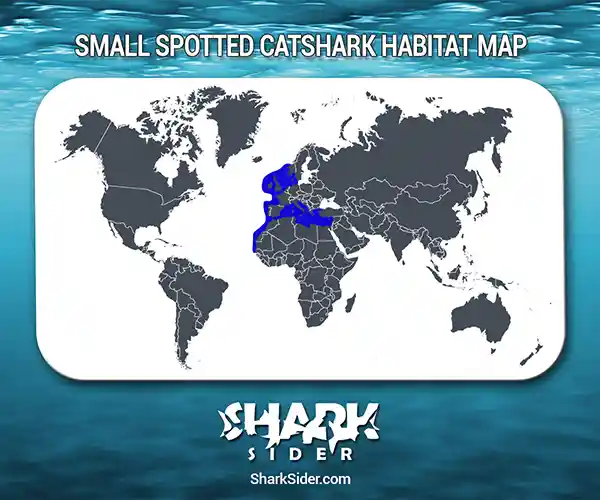The small-spotted catshark, also called the lesser-spotted dogfish, morgay, rough-hound, or sandy dogfish, is a catshark living in the Mediterranean.
Small-spotted Catshark Scientific Classification |
|
| Kingdom | Animalia |
| Phylum | Chordata |
| Class | Chondrichthyes |
| Order | Carcharhiniformes |
| Family | Scyliorhinidae |
| Genus | Scyliorhinus |
| Scientific Name | S. canicula |
Description
The size of this shark ranges from 23.6 to 39.4 inches, and it can weigh up to 4.4 lbs. They have slender bodies, blunt heads, and a skin texture similar to sandpaper. Its dorsal fins are located close to the shark’s tail. The nostrils of the shark are connected to its mouth via a curved groove.
Males tend to have more prominent teeth than females. Also, the size of the teeth can vary based on the distribution, with those living in West African waters having bigger and more powerful jaws with a higher amount of calcination.
When seen from above, these sharks appear greyish brown with dark brown spots all over. When looked at from below, they are greyish-white and much lighter.
Where do they live
Map Of The Small-Spotted Catshark’s Habitat

This shark is found throughout the North Atlantic, encompassing the Mediterranean. Their range is from Norway to Senegal.
Its depth range is between 492 and 1312 ft, with a preference for muddy, rocky, or sandy substrates from the continental shelf to coastal water bodies like estuaries.
Behavior
Feeding
It is a generalist and opportunistic predator, consuming mainly decapod crustaceans, fish, and mollusks but also echinoderms, polychaete worms, sipunculids, and tunicates. Juveniles and young adults will feed on tiny crustaceans, while more mature specimens have a fondness for hermit crabs and mollusks.
The juveniles use an exciting technique to anchor their prey with the help of the dermal denticles of their tail. It’s called “scale rasping” and was first documented in this shark.
Reproductive
These sharks are oviparous, i.e., they lay eggs. The eggs are laid inside cases covered with horns that have tendrils to anchor them against rocks or seaweed.
Small-spotted catsharks mate year-round, but most do so between November and December. Sexual maturity is observed in males when they are 14.6 -19.2 inches and in females when they are 14.3 – 18.4 inches.
Interactions with humans
The IUCN lists the small-spotted catshark as “Least Concern” or “LC” due to their abundance in the Atlantic Ocean.
